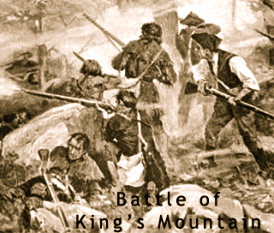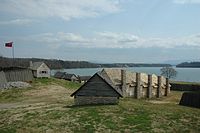Tennessee

French Trader from Revolutionary War Era ~ Sycamore Shoals TN
LivingHistorySites.com brings you a reenactment of a French trader from the Revolutionary War era make contact with Indians, instituting a relationship that will lead to good trade for the Indians and the French. Filmed by Living History Sites entirely on location at Sycamore Shoals State Historic Area in Elizabethton, TN.
 Timeline of Tennessee: 1500’s – 1600’s
Timeline of Tennessee: 1500’s – 1600’s
- (1541) Spanish explorer, Hernando de Soto, first white man to visit area; claimed area for Spain
- (1566) Spaniards built fort near present-day Chattanooga
- (1673) James Needham, Gabriel Arthur of England explored Tennessee River Valley
- (1682) Shawnee Indians driven out by Cherokees; LaSalle claimed Mississippi Valley territory for France; built Fort Prud’Homme near Memphis
1700’s
- (1714) Charles Charleville established French trading post at French Lick
- (1730) Emissary of King George II appointed Chief Moyton “emperor” of Cherokees; England’s sovereignty over Cherokees recognized
 (1750) Dr. Thomas Walker led group of Virgininians into Tennessee; reached Cumberland River and mountains, named for Duke of Cumberland
(1750) Dr. Thomas Walker led group of Virgininians into Tennessee; reached Cumberland River and mountains, named for Duke of Cumberland- (1754) French and Indian Wars broke out between British and French settlers
- (1757) South Carolinians built Fort Loudon on Little Tennessee River
- (1760) Cherokee Indians captured Fort Loudon, killed garrison and nearby settlers
- (1763) French and Indian Wars ended; British won;French surrendered all claims to lands east of Mississippi in Treaty of Paris
- (1768) Iroquois Indians ceded Tennessee land claims to English
- (1772) Group of settlers formed government, Watauga Association
 (1775) Daniel Boone blazed trail from Virginia across mountain at Cumberland Gap to open land for settlement
(1775) Daniel Boone blazed trail from Virginia across mountain at Cumberland Gap to open land for settlement- (1779) Jonesboro became first chartered town, oldest permanent settlement in state
- (1780) Samuel Doak, Presbyterian minister, started first school in Tennessee; John Sevier led group of men at Battle of King’s Mountain to defeat British; Fort Nashborough (Nashville) founded
- (1796) Tennesse became 16th U.S. state
- (1812) Eathquake occurred; tidal waves created on Mississippi River, river flowed backward, formed Reelfort Lake area
- (1815) Tennessee troops led by Andrew Jackson defeated British at Battle of New Orleans
- (1818) Western boundary of Tennessee extended to Mississippi River by Chickasaw Treaty
- (1826) Nashoba, colony for free blacks, established; failed after four years; capitol moved to Nashville
- (1834) State constitution amended, free blacks no longer had voting rights
- (1836) Davy Crockett killed at battle at Alamo
- (1838) Army evicted Cherokee, sent them to Indian territory on “Trail of Tears”; Tennessee first state to pass temperance law
- (1861) Tennessee last state to secede from Union; Civil War began
- (1862) Union troops led by Ulysses S. Grant forced unconditional surrender of Fort Donelson; two-day battle fought at Shiloh; General Forrest defeated Union army at Murfreesboro
 (1864) Confederate army overwhelmed Fort Pillow
(1864) Confederate army overwhelmed Fort Pillow- (1865) Civil War ended; Ku Klux Klan formed; Andrew Johnson elected U.S. president
- (1866) Tennessee first state readmitted to Union; third state to ratify Fourteenth Amendment to constitution
- (1869) President Andrew Johnson impeached; moved to Greeneville
- (1878) 5,200 Memphis residents died due to yellow fever epidemic
- (1894) Shiloh National Military Park created
- (1897) Tennessee Centennial Exposition held in Nashville to celebrate state’s 100th birthday
 Tennessee (
Tennessee (![]() i/tɛnɨˈsiː/) (Cherokee: ᏔᎾᏏ) is a U.S. state located in the Southeastern United States. Tennessee is the 36th most extensive and the 17th most populous of the 50 United States. Tennessee is bordered by Kentucky and Virginia to the north, North Carolina to the east, Georgia, Alabama, and Mississippi to the south, and Arkansas and Missouri to the west. The Appalachian Mountains dominate the eastern part of the state, and the Mississippi River forms the state’s western border. Tennessee’s capital and second largest city is Nashville, which has a population of 626,144. Memphis is the state’s largest city, with a population of 670,902.
i/tɛnɨˈsiː/) (Cherokee: ᏔᎾᏏ) is a U.S. state located in the Southeastern United States. Tennessee is the 36th most extensive and the 17th most populous of the 50 United States. Tennessee is bordered by Kentucky and Virginia to the north, North Carolina to the east, Georgia, Alabama, and Mississippi to the south, and Arkansas and Missouri to the west. The Appalachian Mountains dominate the eastern part of the state, and the Mississippi River forms the state’s western border. Tennessee’s capital and second largest city is Nashville, which has a population of 626,144. Memphis is the state’s largest city, with a population of 670,902.
The state of Tennessee is rooted in the Watauga Association, a 1772 frontier pact generally regarded as the first constitutional government west of the Appalachians. What is now Tennessee was initially part of North Carolina, and later part of the Southwest Territory. Tennessee was admitted to the Union as the 16th state on June 1, 1796. Tennessee was the last state to leave the Union and join the Confederacy at the outbreak of the U.S. Civil War in 1861, and the first state to be readmitted to the Union at the end of the war.
Tennessee furnished more soldiers for the Confederate Army than any other state, and more soldiers for the Union Army than any other Southern state. Tennessee has seen some of the nation’s worst racial strife, from the formation of the Ku Klux Klan in Pulaski in 1866 to the assassination of Martin Luther King in Memphis in 1968. In the 20th century, Tennessee transitioned from an agrarian economy to a more diversified economy, aided at times by federal entities such as the Tennessee Valley Authority. In the early 1940s, Oak Ridge, Tennessee was established to house the Manhattan Project‘s uranium enrichment facilities, helping to build the world’s first atomic bomb.
Tennessee has played a critical role in the development of rock and roll and early blues music. Beale Street in Memphis is considered by many to be the birthplace of the blues, with musicians such as W.C. Handy performing in its clubs as early as 1909. Memphis was also home to Sun Records, where musicians such as Elvis Presley, Johnny Cash, Carl Perkins, Jerry Lee Lewis, Roy Orbison, and Charlie Rich began their recording careers, and where rock and roll took shape in the 1950s. The1927 Victor recording sessions in Bristol generally mark the beginning of the country music genre, and the rise of the Grand Ole Opry in the 1930s helped make Nashville the center of the country music recording industry.
Tennessee’s major industries include agriculture, manufacturing, and tourism.Poultry, soybeans, and cattle are the state’s primary agricultural products, and major manufacturing exports include chemicals, transportation equipment, and electrical equipment. The Great Smoky Mountains National Park, the nation’s most visited national park, is headquartered in the eastern part of the state, and a section of the Appalachian Trail roughly follows the Tennessee-North Carolina border. Other major tourist attractions include Elvis Presley’s Graceland in Memphis and theTennessee Aquarium in Chattanooga.
History – Early history
Mississippian-period shell gorget,Castalian Springs, Sumner County
The area now known as Tennessee was first inhabited by Paleo-Indians nearly 12,000 years ago. The names of the cultural groups that inhabited the area between first settlement and the time of European contact are unknown, but several distinct cultural phases have been named by archaeologists, including Archaic (8000–1000 BC), Woodland (1000 BC–1000 AD), and Mississippian (1000–1600 AD), whose chiefdoms were the cultural predecessors of the Muscogee people who inhabited the Tennessee River Valley prior to Cherokee migration into the river’s headwaters.
The first recorded European excursions into what is now called Tennessee were three expeditions led by Spanish explorers, namely Hernando de Soto in 1540, Tristan de Luna in 1559, and Juan Pardo in 1567. Pardo recorded the name “Tanasqui” from a local Indian village, which evolved to the state’s current name. At that time, Tennessee was inhabited by tribes of Muscogee and Yuchi people. Possibly because of European diseases devastating the Native tribes, which would have left a population vacuum, and also from expanding European settlement in the north, the Cherokee moved south from the area now called Virginia. As European colonists spread into the area, the native populations were forcibly displaced to the south and west, including all Muscogee and Yuchi peoples, the Chickasaw, and Choctaw.
Reconstruction of Fort Loudon, the first British settlement in Tennessee
The first British settlement in what is now Tennessee was Fort Loudoun, near present-day Vonore. Fort Loudoun became the westernmost British outpost to that date. The fort was designed by John William Gerard de Brahm and constructed by forces under British Captain Raymond Demeré. After its completion, Captain Raymond Demeré relinquished command on August 14, 1757 to his brother, Captain Paul Demeré. Hostilities erupted between the British and the neighboring Overhill Cherokees, and a siege of Fort Loudoun ended with its surrender on August 7, 1760. The following morning, Captain Paul Demeré and a number of his men were killed in an ambush nearby, and the most of the rest of the garrison was taken prisoner.
In the 1760s, long hunters from Virginia explored much of East and Middle Tennessee, and the first permanent European settlers began arriving late in the decade. The vast majority of 18th century settlers were English or of primarily English descent but nearly 20% of them were also Scotch-Irish. These settlers formed the Watauga Association, a community built on lands leased from the Cherokee peoples.
During the American Revolutionary War, Fort Watauga at Sycamore Shoals (in present-day Elizabethton) was attacked (1776) by Dragging Canoe and his warring faction of Cherokee who were aligned with the British Loyalists. These renegade Cherokee were referred to by settlers as the Chickamauga. They opposed North Carolina’s annexation of the Washington District and the concurrent settling of the Transylvania Colony further north and west. The lives of many settlers were spared from the initial warrior attacks through the warnings of Dragging Canoe’s cousin, Nancy Ward. The frontier fort on the banks of the Watauga River later served as a 1780 staging area for the Overmountain Men in preparation to trek over the Appalachian Mountains, to engage, and to later defeat the British Army at the Battle of Kings Mountain in North Carolina.
Three counties of the Washington District (now part of Tennessee) broke off from North Carolina in 1784 and formed the State of Franklin. Efforts to obtain admission to the Union failed, and the counties (now numbering eight) had re-joined North Carolina by 1789. North Carolina ceded the area to the federal government in 1790, after which it was organized into the Southwest Territory. In an effort to encourage settlers to move west into the new territory, in 1787 the mother state of North Carolina ordered a road to be cut to take settlers into the Cumberland Settlements—from the south end of Clinch Mountain (in East Tennessee) to French Lick (Nashville). The Trace was called the “North Carolina Road” or “Avery’s Trace,” and sometimes “The Wilderness Road (although it should not be confused with Daniel Boone‘s “Wilderness Road” through the Cumberland Gap).
Statehood (1796)
Tennessee was admitted to the Union on June 1, 1796 as the 16th state. It was the first state created from territory under the jurisdiction of the United States federal government. Apart from the former Thirteen Colonies only Vermont and Kentucky predate Tennessee’s statehood, and neither was ever a federal territory. The state boundaries, according to the Constitution of the State of Tennessee, Article I, Section 31, stated that the beginning point for identifying the boundary was the extreme height of the Stone Mountain, at the place where the line of Virginia intersects it, and basically ran the extreme heights of mountain chains through the Appalachian Mountains separating North Carolina from Tennessee past the Indian towns of Cowee and Old Chota, thence along the main ridge of the said mountain (Unicoi Mountain) to the southern boundary of the state; all the territory, lands and waters lying west of said line are included in the boundaries and limits of the newly formed state of Tennessee. Part of the provision also stated that the limits and jurisdiction of the state would include future land acquisition, referencing possible land trade with other states, or the acquisition of territory from west of the Mississippi River.
During the administration of U.S. President Martin Van Buren, nearly 17,000 Cherokees—along with approximately 2,000 black slaves owned by Cherokees—were uprooted from their homes between 1838 and 1839 and were forced by the U.S. military to march from “emigration depots” in Eastern Tennessee (such as Fort Cass) toward the more distant Indian Territory west of Arkansas. During this relocation an estimated 4,000 Cherokees died along the way west. In the Cherokee language, the event is called Nunna daul Isunyi—”the Trail Where We Cried.” The Cherokees were not the only Native Americans forced to emigrate as a result of the Indian removal efforts of the United States, and so the phrase “Trail of Tears” is sometimes used to refer to similar events endured by other Native American peoples, especially among the “Five Civilized Tribes“. The phrase originated as a description of the earlier emigration of the Choctaw nation.
Civil War and Reconstruction
The Battle of Franklin, November 30, 1864
In February 1861, secessionists in Tennessee’s state government—led by Governor Isham Harris—sought voter approval for a convention to sever ties with the United States, but Tennessee voters rejected the referendum by a 54–46% margin. The strongest opposition to secession came from East Tennessee (which later tried to form a separate Union-aligned state). Following the Confederate attack upon Fort Sumter in April and Lincoln’s call for troops from Tennessee and other states in response, Governor Isham Harris began military mobilization, submitted an ordinance of secession to the General Assembly, and made direct overtures to the Confederate government. The Tennessee legislature ratified an agreement to enter a military league with the Confederate States on May 7, 1861. On June 8, 1861, with people in Middle Tennessee having significantly changed their position, voters approved a second referendum calling for secession, becoming the last state to do so.
Many major battles of the American Civil War were fought in Tennessee—most of them Union victories. Ulysses S. Grant and the U.S. Navy captured control of the Cumberland and Tennessee rivers in February 1862. They held off the Confederate counterattack at Shiloh in April. Memphis fell to the Union in June, following a naval battle on the Mississippi River in front of the city The Capture of Memphis and Nashville gave the Union control of the western and middle sections; this control was confirmed at the Battle of Murfreesboro in early January 1863 and by the subsequent Tullahoma Campaign.
The Battle of Franklin, November 30, 1864
Confederates held East Tennessee despite the strength of Unionist sentiment there, with the exception of extremely pro-Confederate Sullivan County. The Confederates besieged Chattanooga during the Chattanooga Campaign in early fall 1863, but were driven off by Grant in November. Many of the Confederate defeats can be attributed to the poor strategic vision of General Braxton Bragg, who led the Army of Tennessee from Perryville, Kentucky to Confederate defeat at Chattanooga.
The last major battles came when the Confederates invaded Middle Tennessee in November 1864 and were checked at Franklin, then completely diminished by George Thomas at Nashville in December. Meanwhile the civilian Andrew Johnson was appointed military governor of the state by President Abraham Lincoln.
When the Emancipation Proclamation was announced, Tennessee was mostly held by Union forces. Thus, Tennessee was not among the states enumerated in the Proclamation, and the Proclamation did not free any slaves there. Nonetheless, enslaved African Americans escaped to Union lines to gain freedom without waiting for official action. Old and young, men, women and children camped near Union troops. Thousands of former slaves ended up fighting on the Union side, nearly 200,000 in total across the South, and some 30,000 blacks fought for the Confederates.
Tennessee’s legislature approved an amendment to the state constitution prohibiting slavery on February 22, 1865. Voters in the state approved the amendment in March.[31] It also ratified the Thirteenth Amendment to the United States Constitution (abolishing slavery in every state) on April 7, 1865.
In 1864, Andrew Johnson (a War Democrat from Tennessee) was elected Vice President under Abraham Lincoln. He became President after Lincoln’s assassination in 1865. Under Johnson’s lenient re-admission policy, Tennessee was the first of the seceding states to have its elected members readmitted to the U.S. Congress, on July 24, 1866. Because Tennessee had ratified the Fourteenth Amendment, it was the only one of the formerly secessionist states that did not have a military governor during the Reconstruction period.
After the formal end of Reconstruction, the struggle over power in Southern society continued. Through violence and intimidation against freedmen and their allies, White Democrats regained political power in Tennessee and other states across the South in the late 1870s and 1880s. Over the next decade, the state legislature passed increasingly restrictive laws to control African Americans. In 1889 the General Assembly passed four laws described as electoral reform, with the cumulative effect of essentially disfranchising most African Americans in rural areas and small towns, as well as many poor Whites. Legislation included implementation of a poll tax, timing of registration, and recording requirements. Tens of thousands of taxpaying citizens were without representation for decades into the 20th century. Disfranchising legislation accompanied Jim Crow laws passed in the late 19th century, which imposed segregation in the state. In 1900, African Americans made up nearly 24% of the state’s population, and numbered 480,430 citizens who lived mostly in the central and western parts of the state.
In 1897, Tennessee celebrated its centennial of statehood (though one year late of the 1896 anniversary) with a great exposition in Nashville. A full scale replica of the Parthenon was constructed for the celebration, located in what is now Nashville’s Centennial Park.





